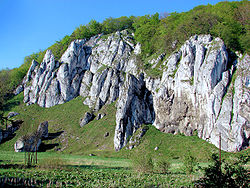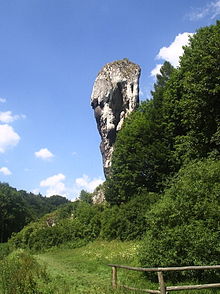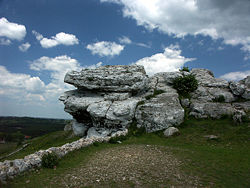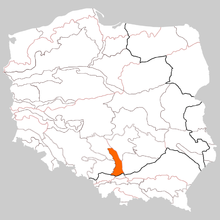- Kraków-Częstochowa Upland
-
 Polish Jura, Glove Rock (Skała Rękawica) at Ojców National Park
Polish Jura, Glove Rock (Skała Rękawica) at Ojców National Park
 Polish Jura, Hercules' Bludgeon (Maczuga Herkulesa)
Polish Jura, Hercules' Bludgeon (Maczuga Herkulesa)
The Kraków-Częstochowa Upland, also known as the Polish Jurassic Highland or Polish Jura (Polish: Jura Krakowsko-Częstochowska), is part of the Jurassic System of south–central Poland, stretching between the cities of Kraków, Częstochowa and Wieluń. The Polish Jura borders the Carpathian Mountains to the south, including part of the Carpathians of the Slovak Republic and the highland of Central Poland to the north, toward the Świętokrzyskie Mountains (Polish: Góry Świętokrzyskie).
The Polish Jura consists of a hilly landscape with Jurassic limestone rocks, cliffs, valleys and vast limestone formations, featuring some 220 caves. The relief of the upland developed since the Paleogene, under climatic conditions changing considerably. Its main component is a peneplain, crowned by monadnocks, rocky masses that resisted erosion, generated as hard rock on Late Jurassic buildup surrounded by less resistant bedded limestone of the same age.[1] The Polish Jura is visited by roughly 400,000 visitors a year. Part of it belongs to the Ojców National Park, the smallest of Poland's twenty national parks, ranking among the most attractive recreational areas of the country.[2]
Contents
Flora and fauna
The Kraków-Częstochowa Jurassic Upland consists of a rich ecosystem, where completely opposite plants coexist in the same timeframe, partly because of the unique microclimate and also, because of the whole upland being surrounded by virgin forest.[3] Plant and animal life is very biodiverse with over 1600 species of plants and 5500 species of animals. These include 4600 species of insects, including 1700 of beetles and 1075 of butterflies and 135 of birds. Mammals include the beaver, badger, ermine and 15 species of bats, many of which hibernate in the park's caves during the winter.
The climate of the upland differs significantly from the surrounding area. The snowpack covers the area for 80 days a year and the rainy season lasts from April until September. Annual precipitation varies between 650-700 mm, higher than in surrounding regions, the median temperature is lower, from 0.5 to 1.0°C. Average temperature is 19°C in summer and -3°C in winter.
There are a number of rivers that originate from the Kraków-Częstochowa Upland, among them the Warta, Biała Przemsza, Pilica, Dłubnia, Szreniawa, Prądnik, Wiercica and Rudawa.
Apart from a diversity of plant and animal species, one can find a unique cultural landscape with archeological objects and relics of ancient inhabitation, with a vast collection of artifacts. The earliest settlement in the area dates to the Paleolithic period, approximately 12,000 years ago. The region is rich in flint, which attracted early humans.
See also
References
- ^ "Pattern of karst landscape of the Cracow Upland (South Poland)" by Witold Stefan Alexandrowicz and Zofia Alexandrowicz, Acta Carsologica, Slovenian Academy Of Sciences [1]
- ^ Congress of the Jurassic System, Kraków, Poland.
- ^ "Krakow - Czestochowa Upland", Agencja Promocji Regionów ORANET. (Polish)
External links
 Media related to Polish Jura at Wikimedia CommonsCategories:
Media related to Polish Jura at Wikimedia CommonsCategories:- Mountain ranges of Poland
Wikimedia Foundation. 2010.


